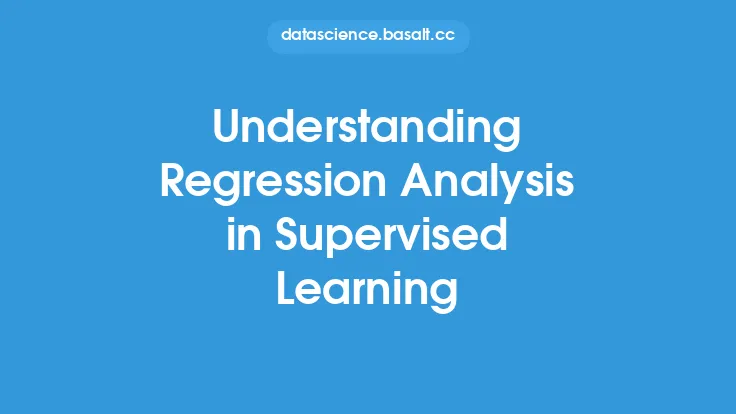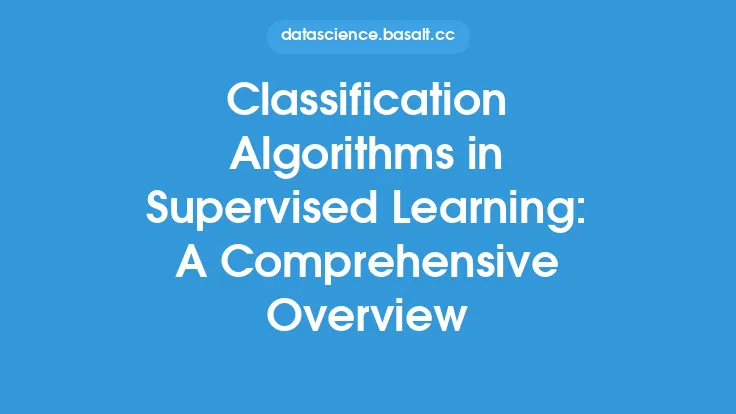Logistic regression is a widely used algorithm in machine learning and statistics that helps predict the outcome of a categorical dependent variable based on one or more predictor variables. It is a fundamental technique in regression analysis, particularly useful when the target variable is binary, meaning it can take only two possible values, such as 0 and 1, yes and no, or true and false. The algorithm is essential in various fields, including medicine, social sciences, and marketing, where predicting probabilities of certain events or behaviors is crucial.
Introduction to Logistic Regression
Logistic regression is based on the logistic function, which maps any real-valued number to a value between 0 and 1. This function is often represented as the sigmoid function, given by the formula:
\[ \sigma(x) = \frac{1}{1 + e^{-x}} \]
where \(e\) is the base of the natural logarithm. The logistic function is used to model the probability of the dependent variable being in one of the two categories, given the values of the predictor variables. The logistic regression model can be represented as:
\[ P(Y=1|X) = \frac{1}{1 + e^{-(\beta_0 + \beta_1X)}} \]
where \(P(Y=1|X)\) is the probability of the dependent variable \(Y\) being 1 given the predictor variable \(X\), \(\beta_0\) is the intercept or constant term, and \(\beta_1\) is the coefficient of the predictor variable.
Assumptions of Logistic Regression
For logistic regression to be applicable and to ensure the validity of the results, certain assumptions must be met. These include:
- Independence of Observations: Each observation should be independent of the others. This means that the observations should not be paired or matched in any way.
- Linearity in the Log Odds: The relationship between the predictor variables and the log odds of the outcome should be linear. This assumption can be checked using diagnostic plots.
- No Multicollinearity: The predictor variables should not be highly correlated with each other. High multicollinearity can lead to unstable estimates of the regression coefficients.
- No Outliers: The data should not contain outliers, which are observations that are significantly different from the other observations. Outliers can affect the estimates of the regression coefficients.
Estimation of Parameters
The parameters of the logistic regression model, namely the coefficients \(\beta_0\) and \(\beta_1\), are typically estimated using the method of maximum likelihood. This involves finding the values of the coefficients that maximize the likelihood of observing the data given the model. The likelihood function for logistic regression is given by:
\[ L(\beta_0, \beta_1) = \prod_{i=1}^{n} P(Y_i|X_i)^{Y_i} (1-P(Y_i|X_i))^{1-Y_i} \]
where \(n\) is the number of observations, \(Y_i\) is the \(i^{th}\) observation of the dependent variable, and \(X_i\) is the \(i^{th}\) observation of the predictor variable. The maximum likelihood estimates of the coefficients are found by taking the logarithm of the likelihood function, differentiating it with respect to the coefficients, setting the derivatives equal to zero, and solving for the coefficients.
Interpretation of Results
The results of logistic regression are often interpreted in terms of odds ratios. The odds ratio is the ratio of the odds of an event occurring in one group to the odds of it occurring in another group. In logistic regression, the odds ratio is given by:
\[ OR = e^{\beta_1} \]
where \(\beta_1\) is the coefficient of the predictor variable. An odds ratio greater than 1 indicates that the predictor variable is associated with an increased likelihood of the event occurring, while an odds ratio less than 1 indicates that the predictor variable is associated with a decreased likelihood of the event occurring.
Applications of Logistic Regression
Logistic regression has a wide range of applications in various fields. Some of the key applications include:
- Credit Risk Assessment: Logistic regression is used in credit risk assessment to predict the likelihood of a customer defaulting on a loan.
- Medical Diagnosis: Logistic regression is used in medical diagnosis to predict the likelihood of a patient having a certain disease based on their symptoms and test results.
- Marketing: Logistic regression is used in marketing to predict the likelihood of a customer responding to a promotional offer.
- Social Sciences: Logistic regression is used in social sciences to study the relationship between various factors and outcomes such as education, income, and crime.
Advantages and Limitations
Logistic regression has several advantages, including:
- Easy to Implement: Logistic regression is a relatively simple algorithm to implement, especially when compared to more complex machine learning algorithms.
- Interpretable Results: The results of logistic regression are easy to interpret, especially when expressed in terms of odds ratios.
- Handling Categorical Variables: Logistic regression can handle categorical predictor variables, making it a versatile algorithm for a wide range of applications.
However, logistic regression also has some limitations, including:
- Assumes Linearity: Logistic regression assumes a linear relationship between the predictor variables and the log odds of the outcome, which may not always be the case.
- Sensitive to Outliers: Logistic regression can be sensitive to outliers, which can affect the estimates of the regression coefficients.
- Not Suitable for Complex Relationships: Logistic regression is not suitable for modeling complex relationships between variables, which may require more advanced machine learning algorithms.
Conclusion
Logistic regression is a fundamental algorithm in machine learning and statistics that is widely used for predicting the outcome of a categorical dependent variable. It is based on the logistic function and estimates the probability of the dependent variable being in one of the two categories, given the values of the predictor variables. Logistic regression has a wide range of applications in various fields, including medicine, social sciences, and marketing. While it has several advantages, including ease of implementation and interpretable results, it also has some limitations, including the assumption of linearity and sensitivity to outliers. Despite these limitations, logistic regression remains a powerful tool for data analysis and prediction, and its understanding is essential for any data scientist or statistician.





